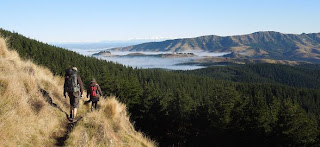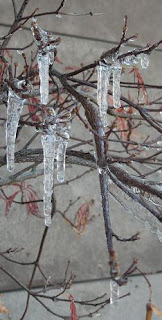
As our wee sprog grows, Stephen and I have looked for shorter and easier hikes to get out and do before our lifestyle is altered drastically. We have also been asked by friends of ours, with no tramping experience, if they might join us on one of our trips. So, we checked out one of our new favorite tramping resources,
tramper.co.nz, and chose a nearby, accessible hike with a great sounding hut at the end of it - Sign of the Packhorse.
Originally built as one of a series of rest stops on a proposed road from Christchurch to Akaroa via the top of the Banks Peninsula, this stone hut has been preserved by DOC as great place to escape to for a picnic lunch or overnight. Nestled in Kaituna Pass, just below Mount Bradley, the cosy 9-bunk hut has expansive views out over Lyttleton Harbor and out towards Te Waihora - Lake Ellesmere. There are numerous routes into the hut, each with their own pros and cons. We chose the route from Gebbies Pass as it gained the least amount of elevation and was the closest access point. This route passes through several farmers properties, mostly through forestry lots, and promised to be an environment neither Stephen, nor I had tramped through before.

We met up with our friends a couple of days before and told them what they might need to pack, gave them a map of the area, and together we went over our planned route. It's great fun introducing someone to something you love and we were keen to make this trip as enjoyable and pleasant as possible so they might continue to tramp in the future. After passing on some spare sleeping bags and packs, we got to sorting the food and packing up ourselves. I say "we", but really, I am allowed to carry very little these days. In fact, I think the sum total of my pack included one mug, my water bottle, some snacks, two books and 4 pencils. Oh, and the first aid kit.

As the tramp is so close to home, there was no rush on the morning of our departure - another bonus point for making tramping accessible. We eventually made it out the door with everyone in tow by 11am and were driving the 30 minutes to our trail head. As soon as we dropped into the Lyttleton Harbor we were greeted by a wall of thick fog. As we arrived at the pull off, we also noted a sign on the gate informing us of ongoing logging and an alteration in the trail to avoid issues. Hmmm, we'd never been tramping through a logging site before. This should be interesting. So, with all these new considerations, we put on our packs and struck out down the muddy, churned up farm road.

The first part of the "trail" is along farm roads. We avoided the odd logging truck by taking the side sheep trail, through dew drenched grass and prickly gorse bushes. Eventually, the trail separates from the road and we found ourselves wandering through rank ordered pine trees with trunks the size of 3 people. The ground littered in long needles made it difficult not to slip down the sometimes steeply slopping ground, but despite my new centre of balance being somewhere out in front of me, I managed not to fall. We wandered through the quiet forest, past grazing sheep and cows, into an open field, before coming over a rise and finding the aforementioned logging site.

This meant mostly noise, mud, and large machines. After carefully negotiating the slopping, muddy roads, we watched from the newly routed trail as bulldozers, grapplers, and harvesters made their way through the maze of massive standing and downed trees. Eventually though, we headed back into the forest (Douglas Fir this time - much darker, denser, and cooler) and on our way. An interesting observation from a pregnant hiker is the strange breathlessness that seems to overtake one on the slightest incline. While I had heard of this and considered it (it makes sense when you think of all your organs being pushed upwards, taking up precious lung space), there is nothing quite like experiencing it. Because, really, there is absolutely nothing you can do except slow down and accept that your lungs are working at reduced capacity. This was a great boon to our friends, who had worried they would hold us up with their slow pace. Instead, it seemed that I was the one bringing up the rear - yet another bonus point for introducing new trampers.

Finally, we emerged from the woods onto a bright sunshiny slope near the tops of the hills. The trail meandered past flighty sheep, amazing dyke formations jutting from the tussocky slope, and around the ridge to Kaituna Pass, and our final destination. We met a family just departing as we arrived, who had kindly filled the hut with fresh firewood and done a great job in cleaning up the hut. Soon, we were left to settle into the hut and relax for the rest of the afternoon. With both the Kaituna Valley and Lyttleton Harbor filled with fog, we felt like we were sailing above the clouds, with only the bleating sheep and cows for company.

After a fancy dinner of sausage and leek risotto, followed by pears with chocolate ginger sauce (all the stops were out to lure our friends into tramping), we settled into our beds to read and dream. Once the darkness had really settled in though, we were startled to see a line of little lights coming down Mount Bradley towards us. Stephen went out to investigate and met with a large group of runners training for an upcoming endurance run in Southland. Our friends were not so interested in this news, only whether they would have to end up sharing their room with more people (this was not something they were keen on). But the runners all decided to run home, and we were left to ourselves for the rest of the night - which despite our day of fog was bright and clear and absolutely filled with stars.

The next morning, we awoke to find some of the fog lifted and some even more settled. We gobbled up some oatmeal (still the easiest tramping breakfast - though I'd be keen to hear of other peoples' favorites) and packed our bags. With the bright sun just coming over Mount Bradley we headed back down the hill (I was very impressed with the speed at which our friends were ready to go in the morning. Not sure if this is a good thing or not, though I did find out later that was the day exam results came out). Back across the tussocky slope, back through the now eerily quiet forest and logging site, and into the fog settled just above our car. Everyone smiling and laughing - a successful weekend all around.







































